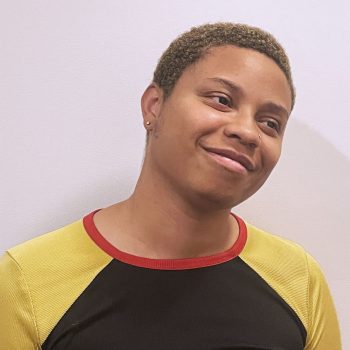
Pap Souleye Fall’s sculptures, drawings, installations, comics and performances are instantly recognizable for their bright colors and mischievous humor, although they also contain a looming darkness. Fall often contemplates both the apocalypse and what it means to owe something to your fellow human. One example: sci fi comic Oblivion Rouge, whose third volume he’s in the process of releasing.
Much of Fall’s current assemblage artwork has spawned from a residency with RAIR, an art studio inside a construction, demolition and recycling waste facility in Northeast Philadelphia. Fall is also currently part of the 10-person iLAB residency cohort at the University of the Arts, his alma mater. Once that program ends, he will return to Dakar, Senegal, where he grew up, for yet another residency, at Black Rock, founded by Obama portraitist Kehinde Wiley.
While Fall’s practice is quite eclectic, his recent endeavors have been grounded by his latest project, Dead Pixel, named for what happens when a pixel on a screen fails, appearing as a black or white spot. Dead Pixel is a comic, an embodied character, and a modality through which Fall has been creating work for the last few years. In public and art contexts, Fall performs as Dead Pixel, roaming about in a handmade outfit that mimics a motion capture suit, a wearable device used in animation that captures the movement of the wearer and translates it into digital data. This play between visibility and invisibility reflects Fall’s contemplations of our current digital and excessive world. He posits, “I was thinking about Dead Pixel, I was thinking about green screen, and I was wondering: What does it mean to sort of digest something in a healthy way?”
This interview has been condensed and edited for clarity.

Logan Cryer: How did you first develop Dead Pixel?
Pap Souleye Fall:
A friend of mine explained to me what dead pixels are. A dead pixel is a problem with the light, but it’s also rendered digitally. It’s this weird bridge between the physical, digital and analog, all happening all at the same time.
When I was living in Senegal a few years ago, there was a matchbox I had that had this stereotypical African figure on it. He’s holding a shoulder strap and it has two gourds on it. He’s by a palm tree, so I’m assuming he’s getting palm nectar, or something like that. That image was so strange to me, because on the bottom it said, “Impregnated matches, manufactured in Sweden.” It’s in English, and this is a Francophone country. I thought that it was an interesting intersection of historical information, present contemporary information but also this weird stereotypical image. So the matchbox was living under all these umbrellas of the past, present, future. One day I was like, I don’t like this, so I painted the figure green. I was like, oh my God, look at that little green figure. That’s Dead Pixel.
Dead Pixel became this sort of spiritual endeavor for me. I’ve done a lot of research around African performances, ritual performances, and how they’re meant to socialize. Even like, someone in an Elmo suit at a block party. That is a social tool and the dancing is to remind us of how we’re supposed to act with each other around each other.
Dead Pixel follows that practice of questioning: What are we socializing? How are we socializing? How are we together with people? And then obviously cosplaying and anime and all that stuff is also deeply in all of that. I had been doing performances and creating characters since high school. I would make clothes and outfits that I would wear. Once Dead Pixel hit, it felt like a culmination of all those things.

LC: What does your artistic practice look like day-to-day?
PSF: I’ll jump from drawing, to video, to performance, to sculpture, and then finally to installation. When I’m not doing sculpture, I have to be drawing. When I’m not doing drawing, I have to be doing performance. When I’m not doing performance, I have to be doing some form of material investigation or making.
LC: Do you make work compulsively, or do you create with a larger goal in mind?
PSF: It’s a bit of both. I’m compelled to fill out the storyline and universe that I’ve set in place for Dead Pixel. For Dead Pixel I wonder: What does the world look like? So that means I need to draw. I also go into writing too. If something is not piecing together well, I’ll do some form of writing in between sketching and sculpture. Creating helps me conceptualize, performance especially helps me. I’m doing a lot with performance this year because I feel like it’s such a great way to map out a whole lot of stuff without taking up too much space.
I think all of it really just boils down to conceptualizing and drawing, because there’s a certain freedom in drawing. I guess I feel that way with performance also, that you’re making images as you’re moving; it’s just a bunch of small images put together.
LC: What did you love about Philly when you came here for college?
PSF: I was just excited to go to a city, but I really loved Philly. There was a lot of stuff going on. I was always out skating around looking for materials, and there was bountiful material everywhere. I was always building installations outside, in lots and stuff. I had built this installation on Broad and Washington , right on that northeast corner [where an apartment building is currently being built]. That was one of my favorite things I ever made. It was going to be this insane, crazy tunnel and I had it up there almost for a whole year while I was building on it. Then I came in one day and this guy pulled up in this really expensive car and was like, “You got to take this down.” And I was like, dang. It was funny.
But yeah, Philly felt like it was a huge point of growth for me as an artist and a person. I’ve made so many amazing friends while I was here and connected with people who really respect my work and are looking to push me and support and help me. That’s the most you can ask for as an artist.

LC: How did your collaboration with RAIR begin?
PSF: I found out about RAIR through seeing Abigail DeVille’s work at the ICA [Philadelphia’s Institute of Contemporary Art]. I was like, oh my God, I really want to do this. So when I came back to Philly, I was like, I’ve got to do the RAIR residency. That experience was amazing. As a space to create, it felt so abundant. Anything you wanted, you could have it. You just pray to the garbage gods and they’ll give it to you. I filled the entire room with so much trash on the first couple days that Billy Dufala [RAIR’s Co-founder and Creative Director] had to tell me, “Okay, you can stop now; there’ll always be more stuff.”
That experience became a huge influence in my work. I was always trying to include an environmental question into my work, because it was always kind of there. That developed while I was at RAIR, thinking about infinity and abundance next to capitalism. It just messed with me, in terms of thinking about the scale of what’s thrown away. It’s infinite, it can’t be quantified.
I was able to do a lecture with Abigail Deville and Billy, and that was one of the best conversations I’ve had. As an artist, you just keep making stuff and I think it’s important to also have a conversation and try to broaden the work, or funnel in on some specific ideas that you were thinking about.
LC: Where do you see your artwork going in the future?
PSF: I have two places where I’ve thought about my work living. So far, none of my work has actually been collected, and I think I’m interested in a collection of some sort to happen, obviously. But the other side of my work also lives within a comic community. I’m always participating in whatever kind of fandom events. Those are nourishing for me. Right now, I’m trying to connect with that world and continue making “fine art” around those spaces.
I have an idea of doing a site-specific installation that would happen at a Comic Con [a convention of comic book aficionados], where there would be an install of Dead Pixel stuff, Dead Pixel merch, sculpture, or maybe some form of performance, all of it sort of living alongside these things, literally intersecting with culture, versus being like, oh, culture is influencing me. I’d literally also be a part of it, but also making art, and also participating.
LC: Your creative work seems very progressive, in the sense that it is always looking for new approaches.
PSF: A friend told me, I have a desire to not be completely Westernized. For me, not being Westernized means changing the way I think about my work and present it and what kinds of dialogues I’m trying to have. I have always had little ways that I like to do that, that allow me to remain fluid. I like formats that allow me to be like, “Hey, I’m also doing comics with some friends, I’m also doing this thing …” It’s about uplifting my community. It’s about sharing resources. It’s about feeling connected with people.
So I take that part of my practice really seriously. The question for me is: How do I bridge that into a fine art space? Is there a sustainable way to do that? Is there a way to create longer-lasting relationships? I don’t know. I don’t know if that’s possible, but that’s the dream.

This story is part of a partnership between The Philadelphia Citizen and Forman Arts Initiative to highlight creatives in every neighborhood in Philadelphia. It will run on both The Citizen and FAI’s websites.







